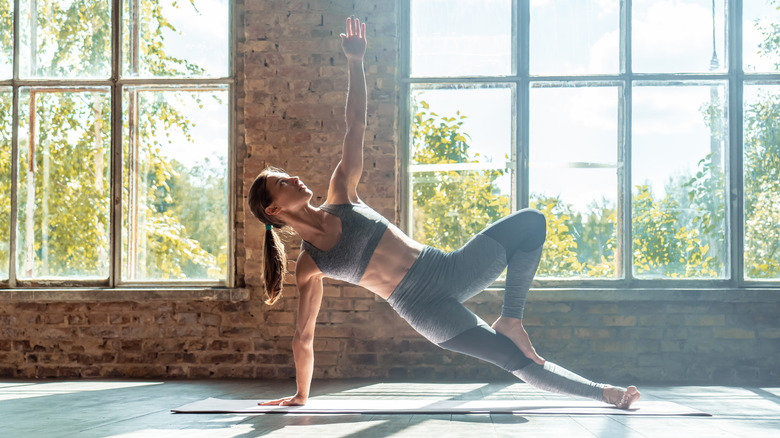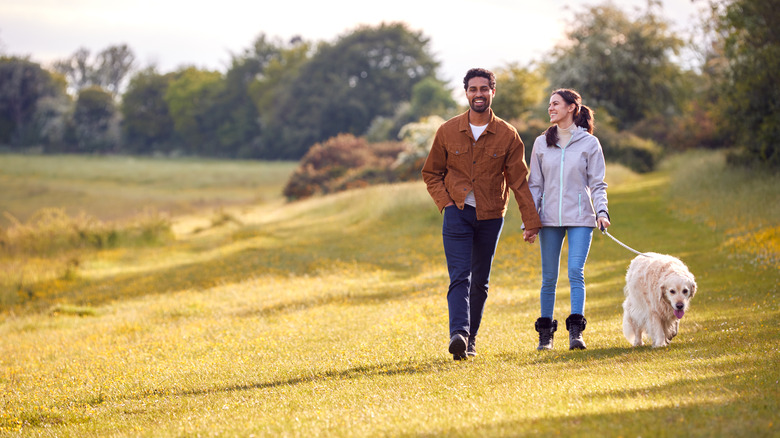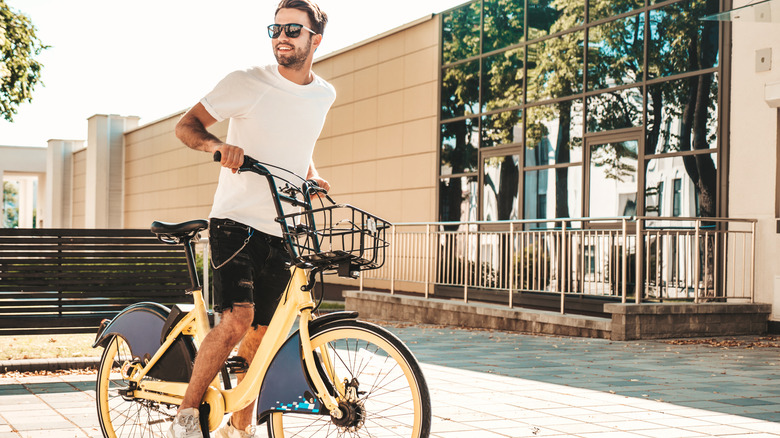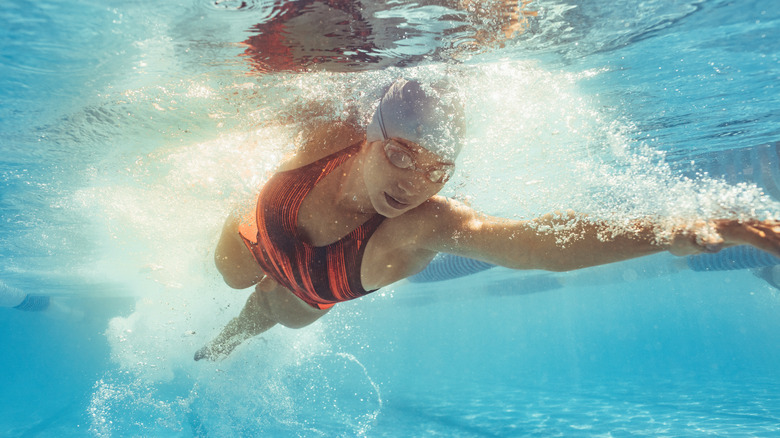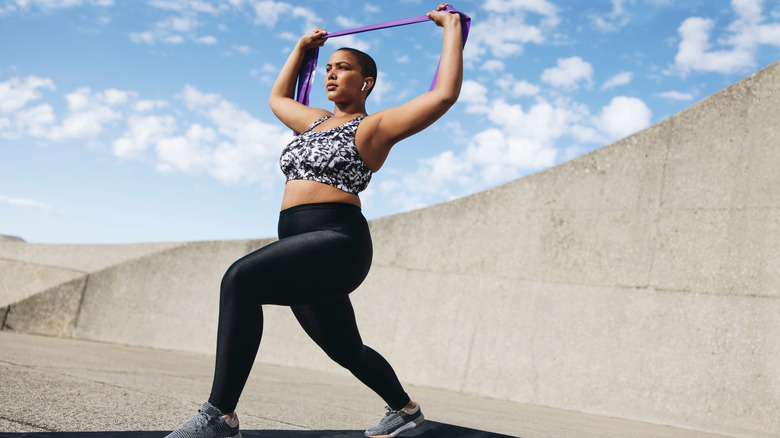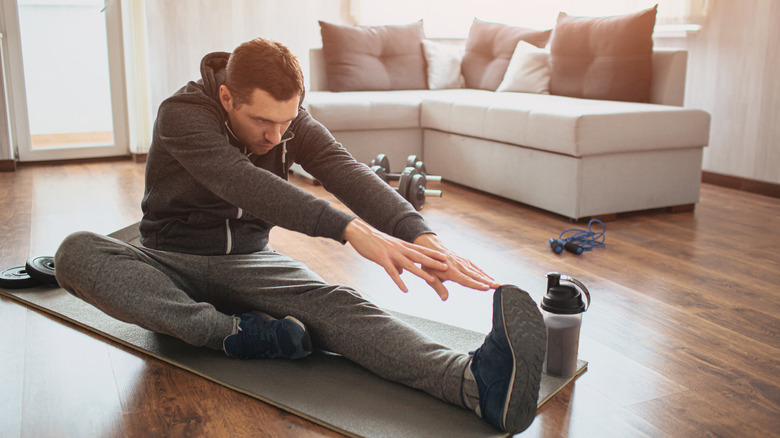The Best Exercises For When You Feel Sore
A sweaty HIIT class, serious strength training session, or challenging half-day hike all can do wonders for the body. But working out can often leave you feeling sore the next day or for several days after. If you're experiencing post-workout soreness, what can you do to relieve your discomfort? How should you care for those sore muscles? It turns out that what you do to help muscle recovery is just as important as your workouts.
Believe it or not, the best thing for your sore muscles isn't to just chill on the couch. In order to jump-start muscle repair and actually ease soreness, Everyday Health recommends six strategies for muscle recovery, including passive recovery (that is, complete rest, and yes it's okay to put your feet up and turn on Netflix) and getting plenty of sleep. In addition, you should be eating foods rich in antioxidants, complex carbs, and lean protein. Foam rolling and massage can speed recovery, too. Finally, one strategy that might seem counter-intuitive but really can do you a world of good while you feel sore is to exercise.
The key is to engage only in low-intensity, low-impact exercise because this type of activity promotes blood flow and tissue repair without further stressing the body (per Everyday Health). In fact, one study published by the Journal of Strength and Conditioning Research found active recovery to be just as beneficial as massages in temporarily relieving muscle soreness.
Add yoga to your cross-training
Practicing yoga in general benefits your body by increasing mobility, building strength, and improving balance and flexibility (per Healthline). When you're experiencing muscle soreness, yoga can be a real balm. That's because during yoga your body moves through a series of full-body motions and holds various poses, which can help you limber up, ease aches and pains, and bring awareness to any postural imbalances.
"Incorporating yoga into your cross-training routine can help prevent injuries and also aid your body in quicker recovery," points out yoga instructor Sharon Ng to VeryWell Fit. Stretching will both ease sore muscles and provide relief for stiff muscles. This is because yoga improves blood flow and circulation which speeds up muscle repair (via Yoga Journal). According to Loren Fishman, medical director of Manhattan Physical Medicine, the best way to fight soreness is to concentrate on the tight muscles and slowly try to relieve the tension (per Yoga Journal). Rather than overstretching the tight muscles, aim to practice gentle yoga poses for some relief. Standing or seated forward bends are a great place to start.
Go on a walk or an easy hike
Walking is an option for active recovery that's hard to say no to. It's easy to do and even a moderate pace has major health benefits for muscle recovery. According to Healthline, leisurely strolling, light jogging, and easy hiking all can reduce muscle soreness and stiffness by increasing blood flow and circulation.
Light exercise also supports the body's inflammatory process (via NBC News). Exercise physiologist and certified strength and conditioning specialist, Matt Unthank explained to NBC News that it helps "lymphatic draining, moving immune cells, and clearing inflammatory mediators" which also strengthens the body.
When it comes to walking as a remedy for post-workout achiness, Flexit master trainer Branko Teodorovic told Well+Good, "It transports all the nutrients necessary to 'feed' the muscles in your legs and to replenish glycogen, our muscle energy. Plus, walking breaks up lactic acid buildup so that your muscles are more prepped for your next training session." As a general rule of thumb, all it takes is 20 to 30 minutes of leisurely strolling to relieve muscle soreness, Teodorovic notes (via Well+Good). It's also a great daily exercise to do.
Hop on your bicycle for a gentle ride
Cycling at a comfortable pace is another great active recovery exercise. Nicole Belkin, an orthopedic surgeon at New York-Presbyterian at Columbia University Irving Medical Center explains via Everyday Health that cycling is a low-intensity cardiovascular exercise that increases circulation and helps move various waste products in the body created from high-intensity exercises. Similar to walking, cycling can help promote muscle repair, but the key here is to not fatigue your muscles or get winded (per EverydayHealth).
Due to the low-impact nature of cycling, it's easy on the knees, legs, feet, and ankles. While cycling, the legs reach a full range of motion which lubricates the joints by producing synovial fluid, explains Jessica Schwartz, spokesperson for American Physical Therapy Association, to Arthritis Foundation. Moreover, cycling supports the skeletal system because it's less-stress bearing on the ligaments, joints, and tendons (per Self). Plus, all you need is ten minutes of cycling a day to improve your fitness (per Self).
Swim a few laps in the pool
Swimming hands-down works wonders for muscle recovery. Not only is it easy on your muscles and joints, but swimming may help reduce inflammation (per Healthline). Head Coach of Life Time Swim of North Carolina Terry Fritch describes swimming as a low-impact exercise for the whole body that uses a variety of movements utilizing all muscle groups and joints "that you may not be able to do on land" (via VeryWell Fit).
A 2010 study published in the International Journal of Sports Medicine tested the recovery effects of swimming on running performance specifically. In the study, nine triathletes ran two high-intensity running intervals. After ten hours, one group performed a recovery swimming session while the other passively recovered. The findings showed those triathletes who swam improved their running performance more than those who did not.
It doesn't take much effort to use swimming as an exercise for active recovery. VeryWell Fit suggests doing a 20-minute swim session starting with a warm-up of breaststrokes and kicks, followed by freestyle swimming ranging from 50 to 100 meters, and ending with a 100-meter cooldown.
Do some resistance band training
Next time you engage in circuit training, try incorporating a set of active recovery exercises using resistance bands in between your high-intensity sets. Your muscles will thank you later (per Healthline).
A study published by the American Council on Exercise tested this idea on athletes who performed running or cycling sessions until they were exhausted. It was found that athletes who continued their workout at 50% energy after they reached fatigue recovered better than those who ended their workout completely.
Exercising with resistance bands the day after a demanding workout also can be a great cross-training exercise (via Healthline). It's easy to adjust the intensity of resistance by using looser or tighter bands, adding or removing bands if you use more than one on the same area, or by moving the band's position on your body (per Women's Health). It's also a great way to tone your entire body.
Practice gentle stretches
One tried and true method for alleviating soreness is stretching. "Stretching and flexibility are underrated," Rick Sharp, professor of exercise physiology at Iowa State University in Ames tells WebMD. Stretching it out actually stops the muscle cycle of soreness to spasms to tightness, explains Sharp.
Keep in mind, stretching is not a magic anti-soreness pill. Complete muscle recovery takes time, stretching or no stretching. But stretching can help move recovery along. The best time to stretch is right after your workout, to start the recovery process and get more blood to your muscles (via Bustle). According to the International Journal of Sports Physical Therapy, there are three forms of stretching: static stretching, dynamic stretching, and pre-contraction stretching. Each one of these can improve range of motion, but more research is needed to understand which eases delayed onset muscle soreness. Adidas states that static stretching post-workout is best for reducing muscle tightness. Slowly stretch your muscle until there's a pull, then hold for 20-90 seconds.
Ultimately, the best recovery exercise comes down to preferences and previous workouts (via Healthline). Go slow, don't exert yourself, and hydrate frequently. Also, remember your nutritional recovery, since food is the foundation for muscle repair (via Everyday Health).


